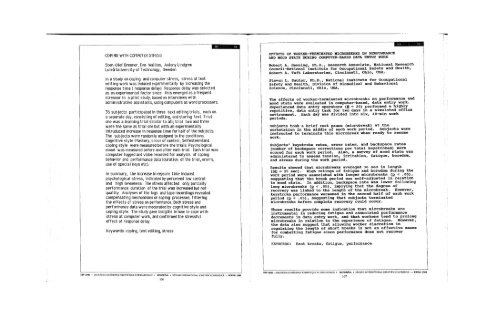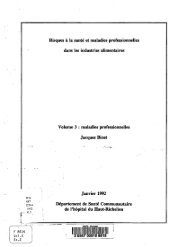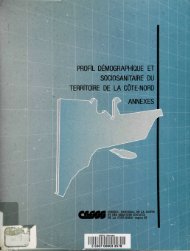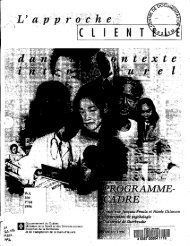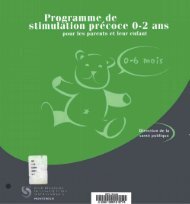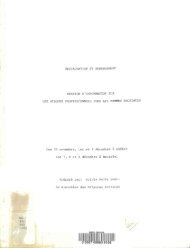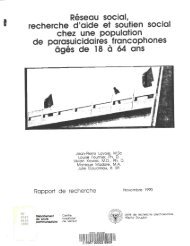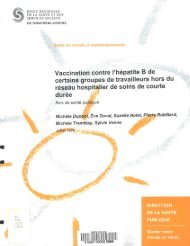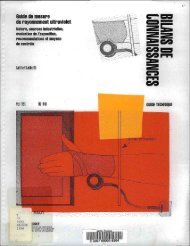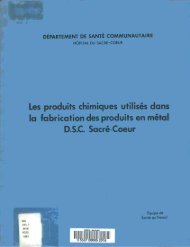SCIENCE, INDUSTRY, AND LABOR FINDINGSON VDT USE AND WORKER HEALTH AND COMFORTA Cal OSHA Committee ReportWanda Smith, Corporate Human Factors Engineering,Hew<strong>le</strong>tt-Packard, U.S.A.Due to a 1987 state Assembly resolution, the CaliforniaOccupational Safety and Health Standards Board appointed acommittee to study: VDT use and <strong>work</strong>er health and thenecessity for VDT regulations. The study was comp<strong>le</strong>ted inApril, 1989.This project is unique because representatives from business,medicine, science and labor <strong>work</strong>ed together to reviewresearch and expert testimony on these topics and <strong>de</strong>velop aseries of joint recommendations. Specifically, the committeemembers consisted of ophthalmologists, optometrists, humanfactors engineers/ergonomists, a psychiatrist, manufacturers,a business manager, an epi<strong>de</strong>miologist, union members,industrial hygienists, and an occupational physician.The committee studied several topics that are oftenassociated <strong>with</strong> VDT comfort and health concerns. Theseinclu<strong>de</strong>d: vision, musculoske<strong>le</strong>tal functions, reproduction,stress and fatigue, and the environmental conditions. Theiractivities inclu<strong>de</strong>d attending presentations by scientificexperts on each topic, quest speakers on specific topics,compiling and analyzing reported research, and <strong>de</strong>veloping areport summarizing findings and recommendations.The committee was asked to try to reach a consensus <strong>with</strong>regard to the results of evi<strong>de</strong>nce and recommendations. Wherethere was agreement that a prob<strong>le</strong>m did exist, the committeemembers were to propose solutions.As a result of this project, and specifically the jointprocess, the committee reached consensus on a number ofconclusions and recommendations. There were also severalareas in which divergent conclusions were reached and these<strong>de</strong>monstrated areas were evi<strong>de</strong>nce was inconclusive and moreresearch is nee<strong>de</strong>d.The paper to be presented will <strong>de</strong>scribe the process of theinvestigation, the findings of the committee on each topic,and the resulting recommendations regarding: regulations,training, and research. The findings of the committee willbe distributed which will inclu<strong>de</strong> the resulting bibliographyof over one thousand research reports.KEYWORDS :Health, vision, musculoske<strong>le</strong>tal, reproduction,stress, environmentURINARY CATECHOLAMINE EXCRETION IN VDT OPERATORSA<strong>de</strong><strong>le</strong> Belisario, Ambra Modiano, Angela Fantini, Giuseppe Olivetti - Istituto di PatologiaSpec.Medica II e Medicina <strong>de</strong>l Lavoro "D.Campanacci" (Direttore: Prof.G.D 1 Antuono) -Université <strong>de</strong>gli Studi di Bologna - Via Massarenti, 9 - 40138 BOLOGNAThe aim of our study was to i<strong>de</strong>ntify and evaluate the condition of stress inducedby VDT operation. Our investigation was conducted utilizing those biohumoral parametersmost valid in stress <strong>de</strong>termination: urinary fractioned catecholamines andrespective metabolite excretion (epinephrine, norepinephrine, VMA, DOPA, HVA) aswell as plasma <strong>le</strong>vels of Cortisol, ACTH, NEFA and fructosamine, <strong>with</strong> samp<strong>le</strong>s beingtaken both before and after the <strong>work</strong> shift.Our study was conducted on 68 VDT operators employed as industry an airport personnel,coMposed of 19 ma<strong>le</strong> and 49 fema<strong>le</strong> subjects <strong>with</strong> an average age of 37 years andhaving a range from 24 to 52 years of age. Out of the original sampling populationall subjects un<strong>de</strong>r medication or in possession of any pathological condition whichmight have altered the biohumoral parameters were eliminated. The resulting datawas analyzed using the Stu<strong>de</strong>nt's paired t test.The possibility of utilizing a seperate control population was rejected based onthe fact that the normal catecholamine range is extremely vast. Thus, we chose touse each subject as his own control by comparing his basal condition <strong>with</strong> thatsubsequent to his <strong>work</strong> shift, in or<strong>de</strong>r to achieve a more valid confrontation.We then procee<strong>de</strong>d to calculate the fractioned catecholamine (basal and after shift)mea:i values as well as the standard <strong>de</strong>viation and conducted an analysis for eachparameter consi<strong>de</strong>red, comparing the basal values <strong>with</strong> those taken right after the<strong>work</strong> shift.Futhermore, the data was subdivi<strong>de</strong>d and subsequently evaluated based on the numberof hours spent at the VDT. Moreover, the same data was analyzed <strong>with</strong> respecb tothe different sectors in which the subjects belonged following the same methodologyas cited above.The data col<strong>le</strong>cted <strong>de</strong>monstrated values contained <strong>with</strong>in the normal range however,after statistical analysis, we discovered a significant increase in epinephrine andnorepinephrine <strong>le</strong>vels taken right after the <strong>work</strong> shift. Likewise, there was aslighter significant increase in the values of DOPA, VMA and NEFA.From this study, two important conditions were observed to have had a significantimpact on the experimental biological parameters un<strong>de</strong>r investigation. The firstconcerning the number of hours spent in front of the vi<strong>de</strong>o terminal and the secondregarding the type of <strong>work</strong> in which the subject was engaged. The operators exposedto the vi<strong>de</strong>o teminal for more than four hours a day had catecholamine valuessuperior to those persons having a <strong>le</strong>sser exposure. It was also found that thoseairport personnel employed in ground control and check-in sectors, which mayrepresent a more stressful situation, presented higher <strong>le</strong>vels of urinary catecholaminesin comparison to fellow airport personnel <strong>work</strong>ing in other sectors.KEYWORDS: stress, health, biohumoral parameters, epi<strong>de</strong>miologyTEV 1989 — DEUXIÈME CONFÉRENCE SCIENTIFIQUE INTERNATIONALE • MONTRÉAL • SECOND INTERNATIONAL SCIENTIFIC CONFERENCE — WWDU 1989TEV 1989 — DEUXIÈME CONFÉRENCE SCIENTIFIQUE INTERNATIONALE • MONTRÉAL • SECOND INTERNATIONAL SCIENTIFIC CONFERENCE — WWDU 1989125
C0PIN6 WITH COMPUTER STRESSSten-Olof Brenner, Eva Wallius, Antony LindgrenLu<strong>le</strong>â University of Technology, Swe<strong>de</strong>nIn a study on coping and computer stress, stress at textediting <strong>work</strong> was Induced experimentally by increasing theresponse time ( response <strong>de</strong>lay). Response <strong>de</strong>lay was se<strong>le</strong>ctedas an experimental factor since this emerged as a frequentstressor in a pilot study, based on Interviews <strong>with</strong>administrative assistants, using computers as word processors.36 subjects participated In three text editing trials, each ona separate day, consisting of editing, and storing text. Trialone was a <strong>le</strong>arning trial similar to all; trial two and threewere the same as trial one but <strong>with</strong> an experimentallyIntruduced Increase in response time for half of the subjects.The subjects were randomly assigned to the conditions.Cognitive sty<strong>le</strong> (Mastery, Locus of control, Selfesteem)aridcoping sty<strong>le</strong> were measured before the trials. Psychologicalmood was measured before and after each trial. Each trial wascomputer logged and vidoe recor<strong>de</strong>d for analysis of copingbehavior and performance data (duration of the trial, erorrs,use of special keys etc).In summary, the increase In repsone time inducedpsychological stress, indicated by perceived low controland high tenseness. The stress affected only partiallyperformance: duration of the trial was Increased but notquality. Analyses of the logs and tape recordings revea<strong>le</strong>dcompensating mechanisms or coping processes, filteringthe effects of stress on performance. Both stress andperformance data were mo<strong>de</strong>rated by cognitive sty<strong>le</strong> andcoping sty<strong>le</strong>. The study gave insigths in how to cope <strong>with</strong>stress at computer <strong>work</strong>, and confirmed the stressfu<strong>le</strong>ffect of response <strong>de</strong>lay.Keywords: coping, text editing, stressEFFECTS OF WORKER-TERMINATED MICROBREAKS ON PERFORMANCEAND MOOD STATE DURING COMPUTER-BASED DATA ENTRY WORKRobert A. Henning, Ph.D., Research Associate, National ResearchCouncil-National Institute for Occupational Safety and Health,Robert A. Taft Laboratories, Cincinnati, Ohio, USA.Steven L. Sauter, Ph.D., National Institute for OccupationalSafety and Health, Division of Biomedical and BehavioralScience, Cincinnati, Ohio, USA.The effects of <strong>work</strong>er-terminated microbreaks on performance andmood state were evaluated in computer-based, data entry <strong>work</strong>.Experienced data entry operators (N = 20) performed a highlyrepetitive, data entry task for two days in a simulated officeenvironment. Each day was divi<strong>de</strong>d into six, 40-min <strong>work</strong>periods.Subjects took a brief rest pause (microbreak) at the<strong>work</strong>station in the midd<strong>le</strong> of each <strong>work</strong> period. Subjects wereinstructed to terminate this microbreak when ready to resume<strong>work</strong>.Subjects 1 keystroke rates, error rates, and backspace rates(number of backspace corrections per total keystrokes) werescored for each <strong>work</strong> period. Also, a survey of mood state wasadministered to assess tension, irritation, fatigue, boredom,and stress during the <strong>work</strong> period.Results showed that microbreaks averaged 36 sec in <strong>le</strong>ngth(SD = 25 sec) . High ratings of fatigue and boredom during the<strong>work</strong> period were associated <strong>with</strong> longer microbreaks (p < .05),suggesting that the break period was self-adjusted in relationto mood state. In addition, backspace rate was lower followinglong microbreaks (p < -05), implying that the <strong>de</strong>gree ofrecovery was linked to the <strong>le</strong>ngth of the microbreak. However,keystroke performance worsened in the second half of each <strong>work</strong>period (p < .05), suggesting that subjects terminatedmicrobreaks before comp<strong>le</strong>te recovery could occur.These results provi<strong>de</strong> some indication that microbreaks areinstrumental in reducing fatigue and associated performance<strong>de</strong>crements in data entry <strong>work</strong>, and that <strong>work</strong>ers tend to prolongmicrobreaks in relation to the experience of fatigue. However,the data also suggest that allowing <strong>work</strong>er discretion inregulating the <strong>le</strong>ngth of short breaks is not an effective meansfor combatting fatigue since performance does not recoverfully.KEYWORDS:Rest breaks, fatigue, performanceTEV 1989 — DEUXIÈME CONFÉRENCE SCIENTIFIQUE INTERNATIONALE • MONTRÉAL • SECOND INTERNATIONAL SCIENTIFIC CONFERENCE — WWDU 1989107TEV 1989 — DEUXIÈME CONFÉRENCE SCIENTIFIQUE INTERNATIONALE • MONTRÉAL • SECOND INTERNATIONAL SCIENTIFIC CONFERENCE — WWDU 1989125


